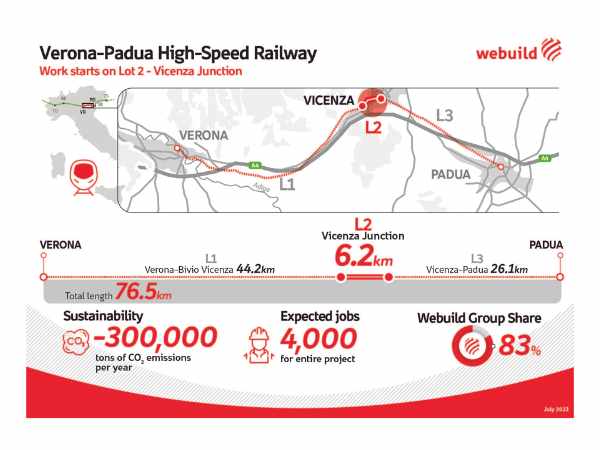The Webuild Group, leader of the Iricav Due Consortium with an 83% stake, has successfully secured a €1.82-billion contract with Rete Ferroviaria Italiana (RFI), the infrastructure arm of FS Italiane Group.
This landmark contract marks the commencement of executive design and construction for the first construction lot (“lotto costruttivo” in Italian) of the Vicenza crossing, a crucial component of the transformative high-speed/high-capacity railway project connecting Verona and Padua.
Iricav Due Consortium
Webuild leads the Iricav Due Consortium, which is responsible for project delivery, and has the following ownership structure:
- We Build Group – 82.93%
- Hitachi Rail STS – 17.05%
- Lamaro Appalti – 0.01%
- Fintecna – 0.01%
WeBuild’s role includes diligently managing the design, carefully monitoring environmental impact, and undertaking civil works and technology installations.
Hitachi Rail is another key partner to the project and brings the ERTMS digital signalling system. This technology will ensure higher train traffic efficiency and enhanced safety, optimizing the usage of rail networks.
Verona to Padua High-speed railway corridor - Project Scope and Status
The Verona-Padua High-Speed Railway is a significant infrastructure project aiming to improve rail connectivity between Verona and Padua in northern Italy. Covering a total length of 76.5 kilometres, the project is divided into three distinct segments, each addressing specific sections of the rail network.

The upcoming new lot of the Verona-Padua High-Speed Railway (lot 2) is set to cover approximately 6.2 kilometres, connecting the town of Altavilla Vicentina to the Vicenza Station (as shown in the picture below). This section will also involve revitalising 4.8 kilometres of the existing line.
Lot | Section | Length (km) | Construction Start | Completion Status |
1 | Verona – Bivio Vicenza | 44.2 | 2020 | 35% complete |
2 | Altavilla Vincentina – Vicenza Station | 6.2 | Soon | Executive Design |
3 | Vicenza – Padua | 26.0 | Soon | Final Design |
Verona to Padua High-speed railway corridor - Economic Goals and Outputs
The high-speed railway project represents a transformative leap forward, fueling Italy’s progress and bolstering its position on the European stage. With an anticipated workforce of up to 4,000 individuals, both directly and indirectly engaged, the project will invigorate the economy and create new avenues for employment, such as:
Supply Chain and Businesses
The railway’s extensive scope has already sparked action within the supply chain, with around 450 companies actively involved in contracts valued at over €1.3 billion. This collaboration strengthens local businesses and industries, fostering a thriving ecosystem of growth and progress.
Improving Connectivity within Italy
Upon completion, the railway will mark a momentous milestone, completing the connection between Milan and Venezia. This enhanced connectivity will enable seamless and sustainable travel for people and goods, revitalizing one of Italy’s most industrious regions.
Strategic European Integration
As a crucial component of the Mediterranean Corridor within the Trans-European Transport Network (TEN-T), the project positions Italy at the heart of Europe’s transport system. The European Union’s investment in this initiative further cements interconnections and sustainable mobility across the continent.













